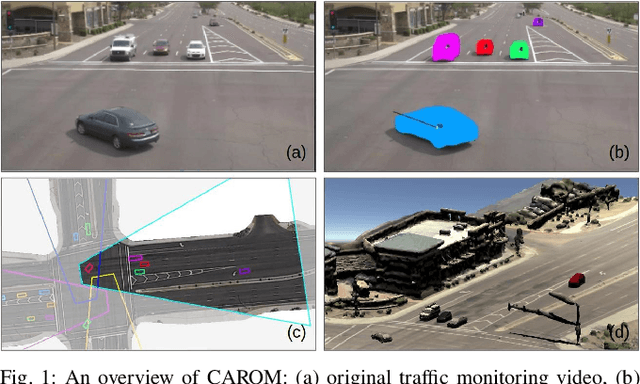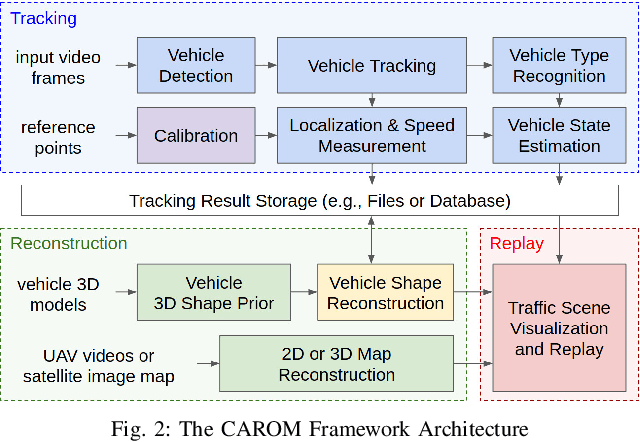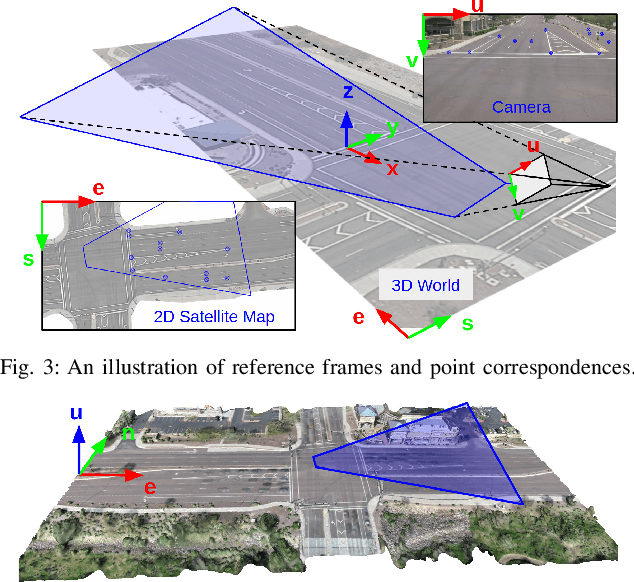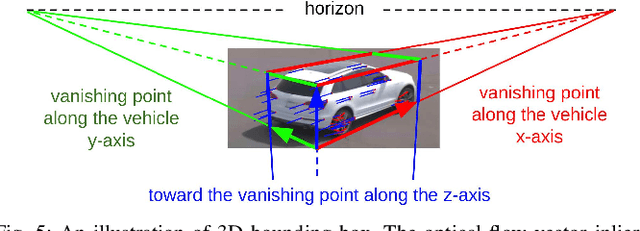Duo Lu
Roundabout Dilemma Zone Data Mining and Forecasting with Trajectory Prediction and Graph Neural Networks
Sep 01, 2024



Abstract:Traffic roundabouts, as complex and critical road scenarios, pose significant safety challenges for autonomous vehicles. In particular, the encounter of a vehicle with a dilemma zone (DZ) at a roundabout intersection is a pivotal concern. This paper presents an automated system that leverages trajectory forecasting to predict DZ events, specifically at traffic roundabouts. Our system aims to enhance safety standards in both autonomous and manual transportation. The core of our approach is a modular, graph-structured recurrent model that forecasts the trajectories of diverse agents, taking into account agent dynamics and integrating heterogeneous data, such as semantic maps. This model, based on graph neural networks, aids in predicting DZ events and enhances traffic management decision-making. We evaluated our system using a real-world dataset of traffic roundabout intersections. Our experimental results demonstrate that our dilemma forecasting system achieves a high precision with a low false positive rate of 0.1. This research represents an advancement in roundabout DZ data mining and forecasting, contributing to the assurance of intersection safety in the era of autonomous vehicles.
SynTraC: A Synthetic Dataset for Traffic Signal Control from Traffic Monitoring Cameras
Aug 18, 2024



Abstract:This paper introduces SynTraC, the first public image-based traffic signal control dataset, aimed at bridging the gap between simulated environments and real-world traffic management challenges. Unlike traditional datasets for traffic signal control which aim to provide simplified feature vectors like vehicle counts from traffic simulators, SynTraC provides real-style images from the CARLA simulator with annotated features, along with traffic signal states. This image-based dataset comes with diverse real-world scenarios, including varying weather and times of day. Additionally, SynTraC also provides different reward values for advanced traffic signal control algorithms like reinforcement learning. Experiments with SynTraC demonstrate that it is still an open challenge to image-based traffic signal control methods compared with feature-based control methods, indicating our dataset can further guide the development of future algorithms. The code for this paper can be found in \url{https://github.com/DaRL-LibSignal/SynTraC}.SynTraC
SKoPe3D: A Synthetic Dataset for Vehicle Keypoint Perception in 3D from Traffic Monitoring Cameras
Sep 04, 2023Abstract:Intelligent transportation systems (ITS) have revolutionized modern road infrastructure, providing essential functionalities such as traffic monitoring, road safety assessment, congestion reduction, and law enforcement. Effective vehicle detection and accurate vehicle pose estimation are crucial for ITS, particularly using monocular cameras installed on the road infrastructure. One fundamental challenge in vision-based vehicle monitoring is keypoint detection, which involves identifying and localizing specific points on vehicles (such as headlights, wheels, taillights, etc.). However, this task is complicated by vehicle model and shape variations, occlusion, weather, and lighting conditions. Furthermore, existing traffic perception datasets for keypoint detection predominantly focus on frontal views from ego vehicle-mounted sensors, limiting their usability in traffic monitoring. To address these issues, we propose SKoPe3D, a unique synthetic vehicle keypoint dataset generated using the CARLA simulator from a roadside perspective. This comprehensive dataset includes generated images with bounding boxes, tracking IDs, and 33 keypoints for each vehicle. Spanning over 25k images across 28 scenes, SKoPe3D contains over 150k vehicle instances and 4.9 million keypoints. To demonstrate its utility, we trained a keypoint R-CNN model on our dataset as a baseline and conducted a thorough evaluation. Our experiments highlight the dataset's applicability and the potential for knowledge transfer between synthetic and real-world data. By leveraging the SKoPe3D dataset, researchers and practitioners can overcome the limitations of existing datasets, enabling advancements in vehicle keypoint detection for ITS.
CAROM Air -- Vehicle Localization and Traffic Scene Reconstruction from Aerial Videos
May 31, 2023Abstract:Road traffic scene reconstruction from videos has been desirable by road safety regulators, city planners, researchers, and autonomous driving technology developers. However, it is expensive and unnecessary to cover every mile of the road with cameras mounted on the road infrastructure. This paper presents a method that can process aerial videos to vehicle trajectory data so that a traffic scene can be automatically reconstructed and accurately re-simulated using computers. On average, the vehicle localization error is about 0.1 m to 0.3 m using a consumer-grade drone flying at 120 meters. This project also compiles a dataset of 50 reconstructed road traffic scenes from about 100 hours of aerial videos to enable various downstream traffic analysis applications and facilitate further road traffic related research. The dataset is available at https://github.com/duolu/CAROM.
CAROM -- Vehicle Localization and Traffic Scene Reconstruction from Monocular Cameras on Road Infrastructures
Apr 02, 2021



Abstract:Traffic monitoring cameras are powerful tools for traffic management and essential components of intelligent road infrastructure systems. In this paper, we present a vehicle localization and traffic scene reconstruction framework using these cameras, dubbed as CAROM, i.e., "CARs On the Map". CAROM processes traffic monitoring videos and converts them to anonymous data structures of vehicle type, 3D shape, position, and velocity for traffic scene reconstruction and replay. Through collaborating with a local department of transportation in the United States, we constructed a benchmarking dataset containing GPS data, roadside camera videos, and drone videos to validate the vehicle tracking results. On average, the localization error is approximately 0.8 m and 1.7 m within the range of 50 m and 120 m from the cameras, respectively.
FMCode: A 3D In-the-Air Finger Motion Based User Login Framework for Gesture Interface
Aug 01, 2018



Abstract:Applications using gesture-based human-computer interface require a new user login method with gestures because it does not have a traditional input method to type a password. However, due to various challenges, existing gesture-based authentication systems are generally considered too weak to be useful in practice. In this paper, we propose a unified user login framework using 3D in-air-handwriting, called FMCode. We define new types of features critical to distinguish legitimate users from attackers and utilize Support Vector Machine (SVM) for user authentication. The features and data-driven models are specially designed to accommodate minor behavior variations that existing gesture authentication methods neglect. In addition, we use deep neural network approaches to efficiently identify the user based on his or her in-air-handwriting, which avoids expansive account database search methods employed by existing work. On a dataset collected by us with over 100 users, our prototype system achieves 0.1% and 0.5% best Equal Error Rate (EER) for user authentication, as well as 96.7% and 94.3% accuracy for user identification, using two types of gesture input devices. Compared to existing behavioral biometric systems using gesture and in-air-handwriting, our framework achieves the state-of-the-art performance. In addition, our experimental results show that FMCode is capable to defend against client-side spoofing attacks, and it performs persistently in the long run. These results and discoveries pave the way to practical usage of gesture-based user login over the gesture interface.
FMHash: Deep Hashing of In-Air-Handwriting for User Identification
Jun 10, 2018



Abstract:Gesture biometrics are gaining popularity with gesture input interface on mobile and Virtual Reality (VR) platforms that lack a keyboard or touchscreen to type a password for user authentication. However, less attention is paid to the gesture-based user identification problem, which essentially requires indexing and searching the gesture motion templates in a large database efficiently. In this paper, we propose FMHash, a user identification framework that can generate a compact binary hash code from a piece of in-air-handwriting of an ID string, which allows fast search in a database of in-air-handwriting templates through a hash table. To demonstrate the effectiveness of the framework, we implemented a prototype and report preliminary results (~98% precision and ~93% recall). More detailed evaluation, comparison, and improvement is working-in-progress. The ability of hashing in-air-handwriting pattern to binary code can be used to achieve convenient sign-in and sign-up with in-air-handwriting gesture ID on future mobile and VR devices.
 Add to Chrome
Add to Chrome Add to Firefox
Add to Firefox Add to Edge
Add to Edge